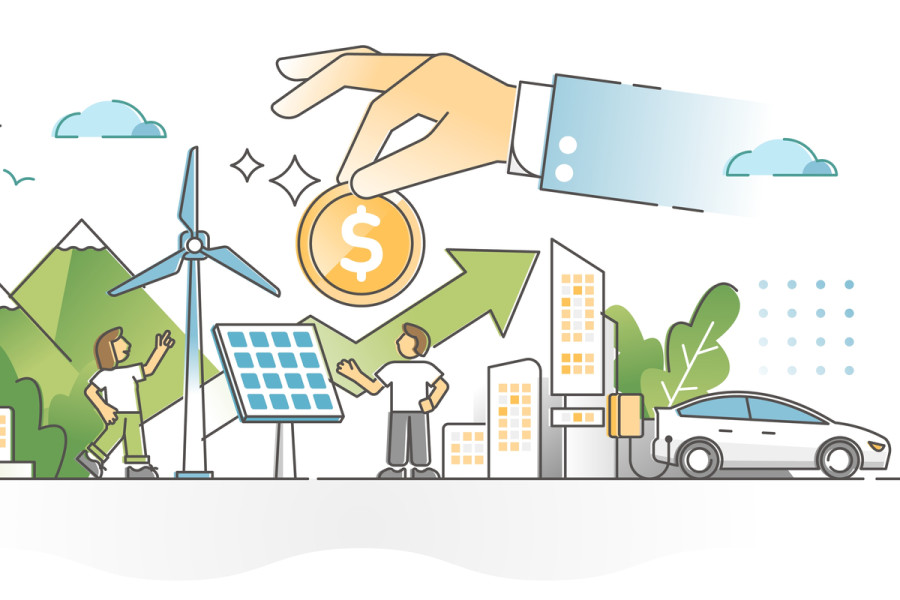Columns
Financing climate adaptation
It is necessary to educate the public that clean energy usage is economically viable.
Siddhant Raj Pandey
November has been scintillating with COP26 deliberations in Glasgow and around the world in various side lines discussing, once again, how to arrest global warming. This time, with net zero pledges. Nepal has been a willing and obedient participant in these conferences through the years and has repeatedly endorsed all actions and commitments. As one of the most vulnerable nations affected by global warming, Nepal has clearly impressed the need for financial support to address this. It now needs to plan to implement climate smart measures and provide the "how" to the "why" billions of dollars are required. The most prudent way forward to accomplish this is to take the private sector into confidence, and plan holistically towards its implementation.
Nepal’s experience with renewable energy goes back to 1968. The government-owned Agriculture Development Bank provided credit to rural energy technologies such as improved water mills and biogas. Biogas was one of Nepal’s success stories. With the establishment of the Alternative Energy Promotion Centre two decades later, subsidising solar installations in rural areas commenced operations. Nepal was the only country in 2008 to participate in Climate Investment Funds projects, the Scaling Up Renewable Energy Programme and the Pilot Programme for Climate Resilience.
Private sector participation
With donor funding, around 2015, the Central Renewable Energy Fund was created as a public-private partnership (PPP) model by partnering with private sector banks to manage the fund. There is considerable institutional knowledge in this area, and the journey forward should pivot from subsidy-based financing in rural energy technologies to a commercially and sustainable financing method. This can only be possible with private sector participation to implement the target of net zero emission by 2045 with a solicitation of $46 billion to fulfil it. Transformational change can only happen with all stakeholders joining hands.
Arguably, the hydropower sector could be considered a successful PPP model; the private sector building the power plants and the government enabling evacuation of the electricity by building transmission lines and also purchasing the power. This success now needs a replication in the rural energy technology sector with an energy mix of clean energy offsetting burning of biomass usage and fossil fuels.
One of the greatest barriers to developing renewable energy technology companies is limited access to financing. Where donor funding is not available, development finance institutions have in recent years been able to address that gap by working directly with the private sector on commercial terms. New forms of access to finance such as private equity is now available as an asset class in Nepal. With the advent of Business Oxygen (BO2) in 2015 with IFC (World Bank Group) funding, it became possible to address the missing middle, that was cut off from formal investment opportunities, to qualify for equity funding.
In 2017, the Climate Investment Funds Pilot Programme for Climate Resilience project injected capital through IFC in BO2. Climate Investment Funds’ investment in the fund facilitated climate smart approaches as well. All investee companies that qualified for investments were vetted to comply with environment, social and governance measures and adopt climate smart approaches. The third investor in BO2 is the Foreign, Commonwealth & Development Office (erstwhile DFID). Two other offshore funds, Dolma Fund and One to Watch, are also active in hydropower and solar photovoltaic investments in the private equity ecosystem.
The investments in Nepal’s largest biogas/fertiliser plant and the first bio pellet producing company, and in solar photovoltaic in the Renewable Energy Service Company model, are some of the successful financing in climate adaptation made by BO2 in recent years. These investments have shown that zero carbon emitting companies assist the environment by replacing dirty fuels such as coal, petrol, diesel and bio mass that a majority of the rural population uses as fuel.
As the production of electricity increases, there is an evident need for demand to also increase. This provides enormous opportunities for the market to pivot from using dirty fuel to clean energy usage such as electrical vehicles, charging stations, and a wide range of cooking, heating, cooling, agriculture and industrial processes that are driven by electricity. The off takers' inability to deliver an uninterrupted supply of power, especially in the dry season, gives enormous opportunities to the solar photovoltaic industry, which can provide short-term reliability, and in the case of rural Nepal, off-grid solutions through installation of solar photovoltaic.
Whether it is solar pumps for irrigation or creation of enterprise through rural electrification, these investments have changed the face of small communities and helped them make ends meet. Recent news of Nepal’s largest cement manufacturer, Hongshi Shivam Cement, finally receiving 30 megawatts from the Nepal Electricity Authority grid that has saved the company thousands of litres of diesel fuel that would otherwise be used to operate its generators on a daily basis, is further example of how the government can work with the private sector to address neutralising carbon emission. In India, producers of bio pellets and industrial consumers get tax concessions to encourage the usage of bio pellets as a replacement to coal. This not only encourages the sale of agricultural waste to make pellets, but incentivises farmers to make money by selling what they have been burning in the open fields causing black carbon emission, one of the causes of environmental disaster in our Himalaya.
Awareness drive
Net metering was a result of persistent lobbying with the government by solar energy groups that enabled roof top solar solutions to be financially viable and attractive to consumers. The government needs to provide various tax concessions to the renewable energy technology industry commensurate with the facilities provided to the hydropower industry to encourage its development. An awareness drive is needed to educate the public that clean energy usage is economically viable, and in the long run, profitable for companies that use climate smart measures.
Nepal’s first bio pellet company, a BO2 investment, buys perennial forest waste from Sagarnath forest in Province 2 and compresses it to make bio pellets, which is a clean alternative to imported coal that our cement industries, tea plantations and brick kilns use. There is a cost to this pivot, and development finance institutions, donors and the government can come in providing alternative forms of financing and technical assistance. The cost is marginal considering what is at stake. Transformational change can only happen if there is top-down, bottom-up, backward and forward collaborations.




 7.12°C Kathmandu
7.12°C Kathmandu















